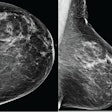Tuesday, November 28 | 3:30 p.m.-3:40 p.m. | SSJ01-04 | Arie Crown Theater
The radiation dose from digital breast tomosynthesis (DBT) varies depending on tissue density, according to research being presented at this Tuesday afternoon session.For the study, a team led by Gisella Gennaro, PhD, of the Veneto Institute of Oncology in Padua, Italy, included 4,764 combination DBT and mammography exams. The researchers calculated volumetric breast density and then mean glandular dose (MGD) for both modalities, adjusting for density. Breast density was grouped into four categories: A, B, C, and D, with A being fatty tissue and D being extremely dense. They also determined the mean dose ratio by dividing the mean glandular dose for DBT by the mean glandular dose for full-field digital mammography.
The mean glandular doses for the four density categories were higher with DBT than with mammography, the group found. For density categories A, B, C, and D, the DBT doses were 3.1, 2.6, 1.8, and 1.4 mGy, respectively, while the mammography dose was 1.9, 1.7, 1.4, and 1.1 mGy, respectively.
The mean dose ratio results show that the tomosynthesis dose increase compared with mammography is higher for fatty breasts than for dense breasts, the group concluded.




















